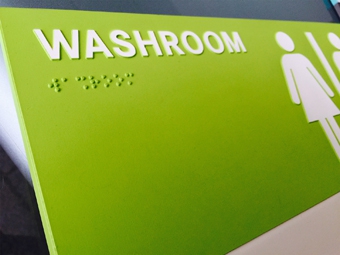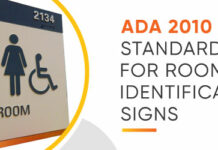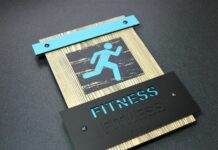Thanks to advances in both substrates and fabricating processes, ADA signage has come a long way from its roots as utilitarian signage.
“Designers and sign makers alike now incorporate ADA-compliant signage as part of their larger signage vision,” says Emily Cordes, product manager at Rowmark. “Customers can decorate ADA-compliant materials through digital printing, custom painting, and full-color sublimation.
“There are now many different colors and substrates that can be used to create ADA-compliant signage, which has opened up a lot of creative possibilities.”
Some of the most common materials used to created ADA signage today are plastics—including acrylic, ABS, and PETG—because of their ease of use and design versatility.
“You see plastic used because really it’s a lot more economical than metal, and it’s relatively easy to use,” says Gary Harder, director of Sign Distribution Products at Gemini.
Metals such as aluminum, steel, zinc, etc., are still frequently used in ADA signs as well.
“Metals are going to be better in higher-end applications or really demanding environments with lots of weather exposure or in a hospital or something like that where they’re cleaning it all the time,” explains Harder.
Metal and plastics may be the most common materials you’ll encounter in ADA signs, but that doesn’t mean that other substrates like glass and wood aren’t being used to make ADA signs as well. It all comes down to making sure the signs are ADA-compliant—no matter the material you use.
“In order for your sign materials to pass ADA regulations, they must have a matte, non-glare finish,” says Cordes. “Surfaces that are high gloss and reflective will not pass sign inspections. It’s also imperative that the sign substrate, pictogram, and characters have proper color contrasts.”
(Note: Consult the 2010 ADA Standards for Accessible Design for full details on making ADA signs compliant.)
Aside from adhering to ADA guidelines, environment is a big factor that will determine what materials a shop should use.
“There are exterior and interior situations, and you have to use the right material to match up to those locations,” says Bob Greenberger, director of Sales at Nova Polymers.
Take acrylic versus ABS, for example. “ABS is more economical, but it’s not rated for exterior, and it doesn’t [possess] a lot of UV resistance,” says Harder. “Say it’s in an entryway where you’re getting a lot of sun shining through the windows; you may still want to go with acrylic, even though it’s an interior application.”
When considering the environment, shops should also keep durability in mind, especially in applications where theft or vandalism may be a problem.
Fabrication also plays a role in durability, as some processes of sign making result in a product that is harder to pick apart or tamper with. The method of fabrication also narrows down the material that can be used.
“The sign fabricator has to consider what techniques do they have for fabricating a sign and what materials are they familiar with?” explains Harder. “It makes sense for them to want to use material that they’re familiar working with. It’s just going to make it easier.”
Generally speaking, if you can laser-engrave a material, then you can almost always route it. However the reverse isn’t true.
For example, PVC is better fabricated with a rotary engraver versus a laser engraver because of the resulting fumes.
In fact, fabrication is another factor that makes acrylic such a popular choice amongst ADA sign makers—it’s one of the few types of plastics that can be used with a laser engraver without any problems.
“If you have a laser and want to use plastic, you’re going to almost always default to acrylic,” says Harder.
Creating signs from photopolymer is also a popular choice.

“For photopolymer, we have six basic materials that can be used, and there are thousands of varieties of those materials,” says Greenberger. “We have PETG; 3form; photoluminescence, which is becoming very important in major cities; aluminum exterior; brushed aluminum; and laminates.”
The photopolymer process is also faster than many other fabrication methods. “We’ve determined that you can produce 400 eight-by-eight-inch signs in an eight-hour shift,” says Greenberger.
Photopolymer can also be finished using CNC routers or laser engravers, depending on the thickness.
“For photopolymer, we can laser-cut up to 1/8-inch, and then above that, you have to go to a CNC machine,” explains Greenberger.
Even outside of photopolymer, a shop should be aware of any design and aesthetic requirements from the client, as well as any ADA requirements.
“The raised text has to be 1/32-inch [minimum] above the substrate—so thickness is a consideration,” says Harder.
Budget also determines the materials. However mixing media in a project may enable a client to include high-end ADA signs with more economical ones.
Greenberger says he’s observed shops using more expensive 3form signs in the more visible front offices and then transitioning to more economical PETG signs at the back of the house, in order to stay within budget.
Mixing materials on individual signs is even possible.
“There are times where you might take 3form and laminate it to a piece of wood or metal to give it a different look,” says Greenberger.
As always, when mixing substrates, it’s important to be sure the sign remains in compliance with ADA standards.
“It’s definitely acceptable to mix media for ADA signage. That being
said, as long as spacing, finishes, and contrasts are compliant, your sign will be as well,” says Cordes. “ADA signage doesn’t have to be stark, and
with the help of frames, standoffs, and
other signage components, it can be visually stunning.”
Whether a sign shop chooses standoffs, frames, or another method of mounting, all depends on the material of the sign.
One of the most common installation methods is to flush-mount the sign to the wall using a tape such as 3M™ High Performance Adhesive Transfer Tape 467MP or ORAFILM® 1375 Transfer Tape.
If vandalism is a concern, sign shops can screw signs directly into the wall.
“The other thing you can do, if the substrate is thick enough, is use a stud mount,” says Harder. “A stud mount is just screwing a stud partway into the back of the sign so that it’s not all the way through the face. If you have a thick enough sign, you can do that.
“Then you drill a hole in the wall, put silicone in the hole, and flush-mount the sign against the wall.”
One of the biggest factors affecting installation is weight.
“For the heavier signs, like zinc, it has to be a hard mount,” says Greenberger. “You just can’t put tape and glue and stick it against that wall and hope it’s going to stay up.”
As expected, sign shops need to be aware of the ADA guidelines when installing signs.
“One of the biggest reasons for not complying to ADA standards is it’s not mounted in the right place,” says Harder. “The ADA has regulations on the placement of the sign relative to the door or the floor.
“[Sign shops will] find that the “where” is going to be more important than the “how.”
By Ashley Bray
Photos (top to bottom): Nova Polymers, Rowmark, Gemini.











